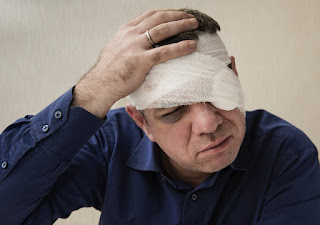Face and Head Injuries are Common in Motorcycle Accidents
Riding a motorcycle can be fun, but in doing so, you expose yourself to a significant degree of risk. As we have discussed in the past, motorcycles offer much less protection than passenger vehicles, so accidents involving motorcycles are much more likely to be accompanied by injuries and even death. In fact, the National Highway Traffic Safety Administration1 (NHTSA) estimates that over 80% of motorcycle accidents result in injury or death to the cyclist. Off all injuries that can occur in a motorcycle crash, head injuries are the most severe. Because motorcycles offer no head protection to the rider and ejection from the motorcycle is very common in accidents, head injuries pose a unique threat to motorcyclists.
Below, we'll take a look at some of the most common types of injuries from motorcycle crashes to see where head injuries fit in the larger picture, then take a more in-depth look at the consequences of head injuries and how to avoid them.
Most Common Motorcycle Accident Injuries
According to the Centers for Disease Control and Prevention2 (CDC), the most common injuries from motorcycle crashes are too the legs and feet, accounting for 30% of all non-fatal motorcycle injuries. The next most common injuries are to the head and neck, making up 22% of all non-fatal motorcycle crash injuries. Going a step further than the CDC, the Association for the Advancement of Automotive Medicine took a more in-depth study that examined the parts of the body that are most likely to be injured in a motorcycle crash broken down by age. The results of that study are shown below in Figure 1, titled "Distribution of Injured Anatomic Region by Age Group."
As shown in Figure 1, by far the most common injuries in motorcycle accident among both age groups studied were injuries to the extremities, both upper and lower. However, when we remove injuries to extremities, which are less likely to be deadly than other injuries, we see that head, face, and neck injuries make up a substantial portion of the remainder, accounting for roughly 20-25% of all injuries for both age groups combined. Thus, it would appear that roughly a quarter of all motorcycle accidents involve injuries to the head, which are among the most serious and potentially life-altering injuries one can suffer.
Dangers of Head Injuries
A traumatic brain injury3 is an injury to the brain that is normally caused by a violent blow or jolt to the head that causes the brain to move back and forth inside the skull, causing multiple points of damage. Because the brain does not heal the same way as other body parts, the effects of traumatic brain injury can be very difficult to overcome, if at all. The immediate effects of traumatic brain injuries are split into physical symptoms and cognitive symptoms. The physical symptoms of mild traumatic brain injuries include loss of consciousness for a few seconds to a few minutes, headache, nausea and vomiting, dizziness and loss of balance, and fatigue or drowsiness. Cognitive symptoms include blurred vision, ringing in the the ears, a bad taste in the mouth, mood swings and mood changes, and memory and concentration problems.
While the effects of a mild traumatic brain injury can cause temporary dysfunction and are treatable by rest and over-the-counter pain relievers, more severe brain injuries can result in bruising, torn tissue, bleeding, and other serious physical damage that can result in long-term complications. These more severe traumatic brain injuries require surgery and extensive rehabilitation. Physical symptoms of moderate to severe traumatic brain injuries can include:
- Loss of consciousness for several hours
- Persistent headache
- Repeated vomiting or nausea
- Convulsions and seizures
- Dilation of the eyes
- Clear fluid drain from the nose and ears
- Inability to awaken from sleep
- Weakness or numbness in fingers and toes
- Loss of coordination
Cognitive symptoms can include:
- Profound confusion
- Agitation and combativeness
- Slurred speech
- Coma and extended loss of consciousness
Longer term symptoms can include depression, persistent ringing in the ears, trouble with balance, and impaired memory and learning.
How to Avoid Head Injuries While Motorcycling
The most effective way to prevent traumatic brain injuries and other head injuries is also the simplest and easiest--wear a helmet! The U.S. General Accounting Office4 (GAO) found that helmeted riders have up to an 85% reduced incidence of severe, serious, and critical injuries than un-helmeted riders. Further, the NHTSA found that motorcycle helmets are 67% effective in preventing brain injuries specifically, while un-helmeted motorcyclists are over three times as likely to suffer a traumatic brain injury than those who were helmeted. Wearing a helmet has other benefits besides preventing injuries as well--the GAO study also found that helmeted riders had a 73% lower fatality rate than un-helmeted riders.
Helmets are so effective at preventing head injury that most states have made wearing helmets mandatory as a matter of public policy through helmet laws. In Florida, a person over 21 years of age may operate a motorcycle without wearing protective headgear only if the person is covered by an insurance policy providing at least $10,000 in medical benefits for injuries incurred as a result of a crash. Motorcycle riders under the age of 16 may not operate a motorcycle or moped without a helmet at all. Violations of this law are non-criminal infractions and are punished by a fine of $35. Although the fine for not wearing a helmet is low, the risks of doing so far outweighs the benefits.
Contact a Clearwater Motorcycle Accident Attorney for a Free Consultation
If you've been involved in a motorcycle accident and have suffered a head injury, please contact the attorneys at the Dolman Law Group for a free consultation by calling 727-451-6900.
Dolman Law Group
800 North Belcher Road
Clearwater, FL 33765
727-451-6900
800 North Belcher Road
Clearwater, FL 33765
727-451-6900





Komentar
Posting Komentar